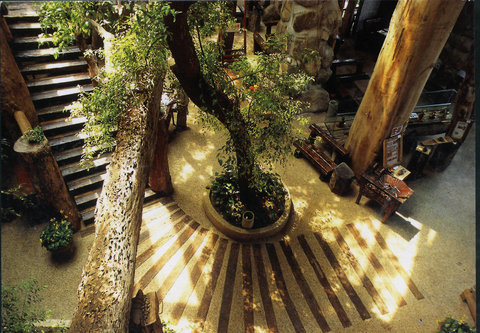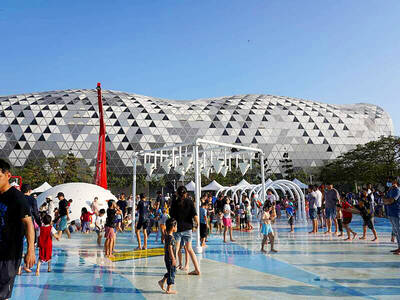As the "2006 Taiwan Lantern Festival" swings into full force in the Anping District (安平區) of Tainan City this weekend, a nearby fairytale-castle restaurant Wu Jiao Chuan Ban -- "Five-Dime Ship Driftwood" -- is worth a visit, if only to get away from the crowds. It is a two-story building that is almost completely hidden behind tall banyan and other trees.
The restaurant can accommodate up to 400 guests. It is located in front of the famous Eternal Golden Castle (億載金城), another hot tourist spot. The decor includes driftwood, high ceilings, roomy dining spaces, huge glass windows by the wall, large wooden dining tables and lots of green plants. The airy and relaxing setting gives diners the feeling of feasting in a forest.
Hsieh Li-siang (謝麗香), the artist-turned restaurant owner, who is in her early 40s, insists on serving Taiwanese and Chinese gourmet dishes to her patrons. She hires chefs from 5-star hotels to design and prepare new dishes and changes her restaurant menus every week.

PHOTO COURTESY OF WU JIAO CHUAN BAN
Hsieh's other two eateries do not appear to be like chain stores. Each one of them is built with distinctive features. They are located in Hsinying (新營), Tainan County and at Wenxin Road (文心路), Taichung City. A fourth restaurant in Neihu District (內湖區), Taipei, is scheduled to open by the end of next month.
The spacious eating tables and long business hours suits people who enjoy long afternoon tea times or late dinners. For this weekend, two signature dishes from the master chef are highly recommended. Five-dime green tea with shrimp (伍角綠茶蝦) is a sauteed dish made with high-quality Da-Mao-Feng green tea (大茅峰綠茶). The Thai-style fried taco steak (泰式花枝排) is crunchy and goes well with the homemade Thai sauce.
The restaurant serves numerous kinds of beverages, including coffee, tea, cocktails and different red wines. The house blend of Taiwan Coffee tastes superb. One popular sticky-rice-like dessert, called xian naini (鮮奶泥), or fresh mild mud, is made from fresh milk and dipped with peanut powder. The dessert usually comes with the meal.
One of the amazing things about Hsieh is that she insists on building her restaurants based on artistic instinct. She takes pride in claiming each restaurant is "a house built by a woman."
She taught herself to apply different media for various art creations and is not shy about showing off her works, such as nude female statues, inside her restaurants. Since this is going to be a busy lantern festival weekend, reservations are a wise idea.

The Taipei Times last week reported that the rising share of seniors in the population is reshaping the nation’s housing markets. According to data from the Ministry of the Interior, about 850,000 residences were occupied by elderly people in the first quarter, including 655,000 that housed only one resident. H&B Realty chief researcher Jessica Hsu (徐佳馨), quoted in the article, said that there is rising demand for elderly-friendly housing, including units with elevators, barrier-free layouts and proximity to healthcare services. Hsu and others cited in the article highlighted the changing family residential dynamics, as children no longer live with parents,

The classic warmth of a good old-fashioned izakaya beckons you in, all cozy nooks and dark wood finishes, as tables order a third round and waiters sling tapas-sized bites and assorted — sometimes unidentifiable — skewered meats. But there’s a romantic hush about this Ximending (西門町) hotspot, with cocktails savored, plating elegant and never rushed and daters and diners lit by candlelight and chandelier. Each chair is mismatched and the assorted tables appear to be the fanciest picks from a nearby flea market. A naked sewing mannequin stands in a dimly lit corner, adorned with antique mirrors and draped foliage

The election of Cheng Li-wun (鄭麗文) as chair of the Chinese Nationalist Party (KMT) marked a triumphant return of pride in the “Chinese” in the party name. Cheng wants Taiwanese to be proud to call themselves Chinese again. The unambiguous winner was a return to the KMT ideology that formed in the early 2000s under then chairman Lien Chan (連戰) and president Ma Ying-jeou (馬英九) put into practice as far as he could, until ultimately thwarted by hundreds of thousands of protestors thronging the streets in what became known as the Sunflower movement in 2014. Cheng is an unambiguous Chinese ethnonationalist,

I was 10 when I read an article in the local paper about the Air Guitar World Championships, which take place every year in my home town of Oulu, Finland. My parents had helped out at the very first contest back in 1996 — my mum gave out fliers, my dad sorted the music. Since then, national championships have been held all across the world, with the winners assembling in Oulu every summer. At the time, I asked my parents if I could compete. At first they were hesitant; the event was in a bar, and there would be a lot